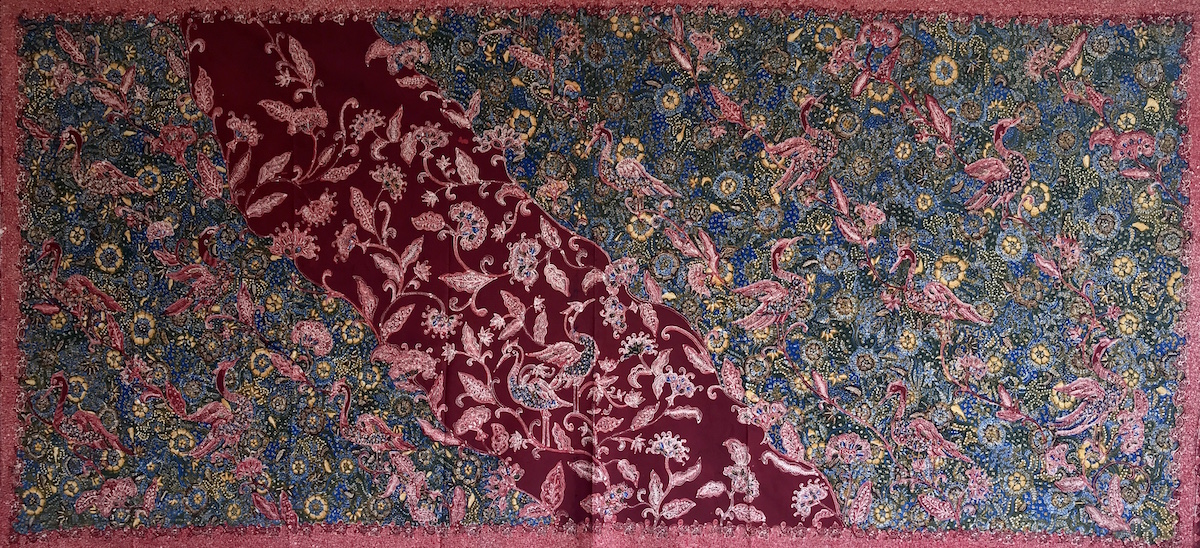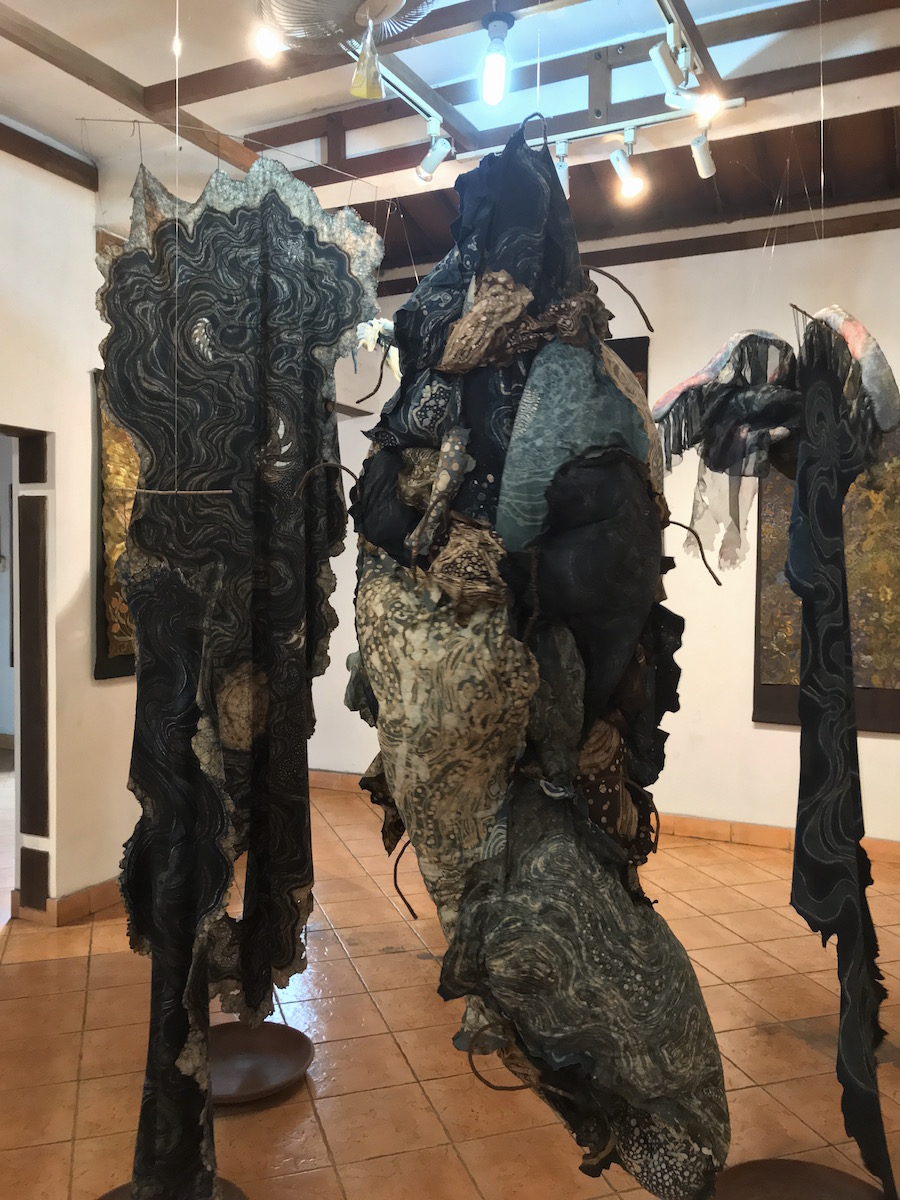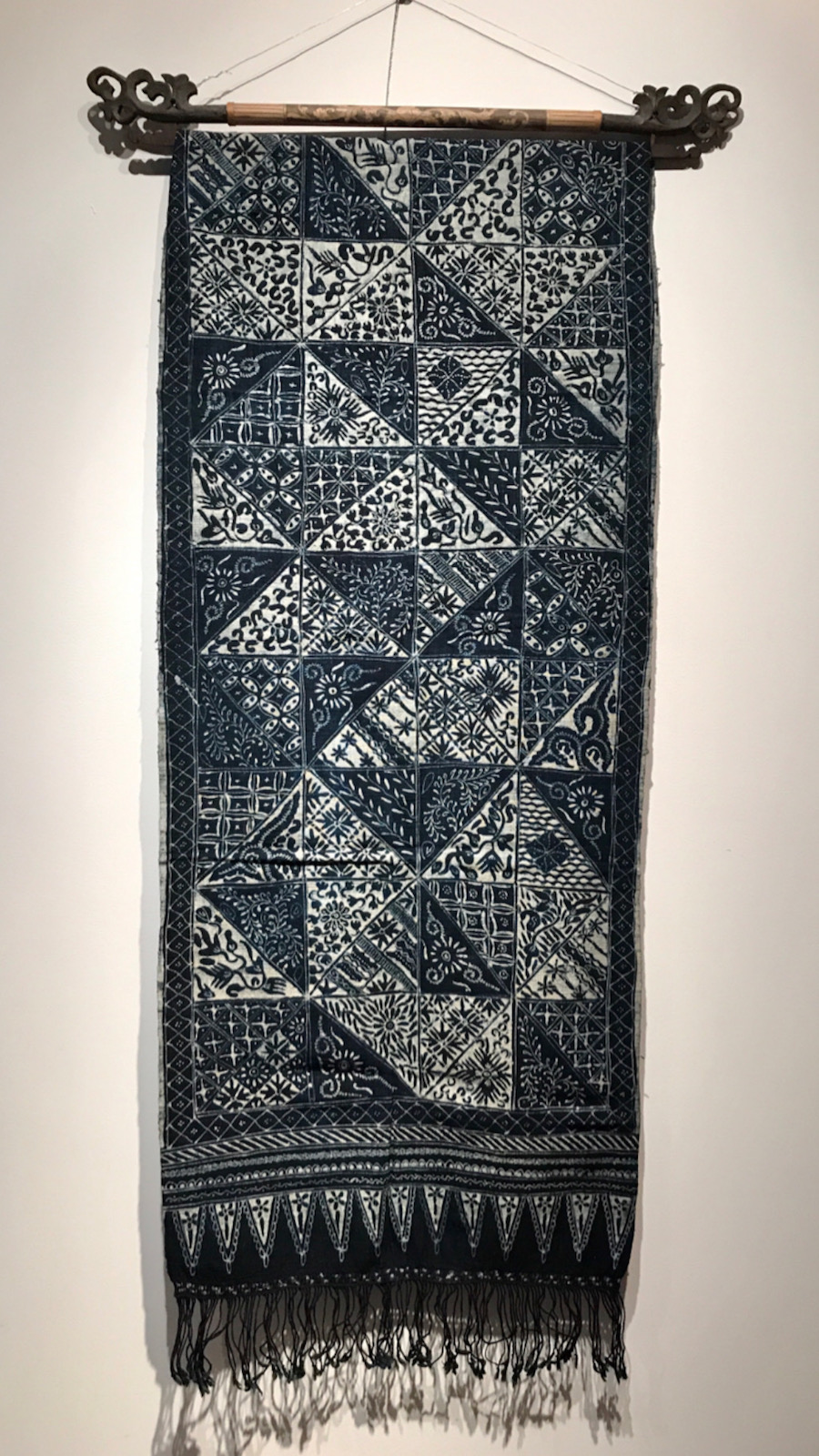Soul of Batik: Healer, Protector or Temptress?

Cranes, a Batik Tiga Negeri from Lasem, a collective work done by eight artisans over three months.
“You need to have ‘chemistry’ to understand this world (of textile),” an veteran collector once told me when I first embarked on this batik journey.
Oh, perfect, at least my Chemistry degree will be useful, I thought.
“Batik will lure you in and captivate you,” he continued in his next breath and… I think I bought a different Chemistry textbook and the page is turning into another realm real quick.
Traditionally, textiles are believed to possess a mysterious energy that can heal any sickness and ward off evil. Batik tambal is believed to patch up the missing “hole” in your body when you are sick and parang is considered to be a powerful protector against evil. Since I went on this train of textile arts ride, I always hear a variation of “the cloth is calling you, dream about it” or “the cloth will speak to you” or maybe, as the millennials call it, “sparks joy”. Who is exactly hiding behind these creations who are the healers and the protectors?
Knock, knock, who’s there? I am the Soul of Batik.
Soul… what? To anyone else, batik and tenun have an element of spiritualism that makes them intriguing and mystical. To me, I fasted, meditated and scoured through search engines and libraries in a quasi-scientific quest to meet this invincible being and ask why are you so charming?
Everybody… introducing the Soul of Batik.
The Power of Three
The practice of batik puts a lot of emphasis on harmony among three entities: human, mother nature and the third realm, following the Javanese philosophy of Tribawana (The Three Worlds). During a recent trip to their studio Brahma Tirta Sari in Yogyakarta, artists Nia and Ismoyo explained that an artist, through self-internalisation, makes a connection with materials from the Earth and expresses those ties through the immaterial realm which is the source of creativity.
This is an ancient creative process and it results in an array of symbols and techniques that are interpreted by different experts to the general audience. As forwarded by sociologist Herbert Blumer in his Symbolic Interactionism theory, one interacts with things based on meanings ascribed to them, based on one’s interaction with others and society, and (re-)interprets them according to specific circumstances.
Symbolic meaning of a ‘kawung’, for example, is often associated with four cardinal points that take on a meaning corresponding to the stages of life in a circular motion going back to the ‘origin’. Also, often used as a representation of a palm tree that is associated with being multi-purpose and as a blessing for great wisdom, kawung reflects the societal influence based on history and culture that have been passed down through generations.
Thoughts: It Began in the Mind

Fertility by Brahma Tirta Sari, is inspired by ants’ nest. Ant is a symbol of fertility in ancient Javanese text, Agastyaparwa.
These interconnections between a human, the environment and the third world is demonstrated through three actions: thoughts, speech and behaviour.
Thought is associated with the conception of a design in an artwork. In batik, each individual element, from the main central motif, to the isen (filler motifs) are carefully selected to fill the empty void in the cloth to express a specific philosophy. Balance of two polar extremes – light and dark, masculine and feminine, fluid and static – is the utmost requirement of a completed work.
For example, in an inland batik motif, associated with Yogyakarta and Solo, to represent the concept of Sangkan Paraning Dumadi (Genesis of Life), pointy meru (a mountain), the tongue of fire, swimming fish/snake and wings of birds were chosen. The elements of life (earth, fire, water and air, respectively) and the kingdoms flora and fauna must be balanced and well-represented in a piece of work (Susanto S., 2018).
The selection of colours also goes through a deliberate thought process. In inland batik, colours are predominantly white and brown and dark blue or black. In one version, it takes on a meaning that white, brown and indigo represents, you guess it, one self, Mother Earth and God. In reality, most natural dyes, sans indigo, move towards brown when heated during wax removal steps. It could be a practical reason that most old royal batik are primarily dyed with brown and indigo and we start assigning meaning to them.
Speech: The Language We Speak
The language of batik is one with dots and lines as the alphabets and geometrical shapes of circles and rectangles as the sentences. Dots and lines are the simplest building blocks that are carefully arranged to endure the rigorous process of waxing and dyeing.
Thick lines represent strength and tidy dots or thin crack lines represent fragility, two opposites that fill each other and make up the cosmic balance. A batik design is not just a piece of ‘motif’ drawn on a cloth but it is a composition of beautiful prose that conveys messages of optimism and spiritual energy.
You don’t need to study this language to understand textile and arts. You have understood it since the day you were born.
Behaviour: The Act of Deliberate Doing
After thinking how to express one self with the “divine” language, the final part is the act of doing, the act of making the batik itself. In the past, artisans fast and meditate so that they can concentrate and make the most beautiful and neatest lines. Breathing with each stroke of hot wax is a deliberate act. It is not just to produce the neatest and the straightest lines but also as a method of meditation to purify the mind and to pour in the prayers and wishes. This is a conscious act of respect for oneself, nature and God.
Applying wax with a canting is not an easy task. It requires patience and discipline – traits that, unfortunately, many younger batik makers are lacking. Nonetheless, patience and discipline is a proof of dedication which translates to love and trust among the artisans and the workshop owners.
Community Spirit: The Last Touch
The world does not only revolve around one artist. Sociologist Max Weber’s The Protestant Ethic and the Spirit of Capitalism theory argues that religious ideas of groups played a role in creating ‘capitalistic’ spirit. One of the four elements in spiritual growth, other than personal, environmental and transcendental, is communal.
In batik cities, like Pekalongan, the social and emotional connection of solidarity during thanksgiving festivals renews the spirit in forwarding the art of batik as a community. (Kanafi I., et. al., 2012). Being in a group of shared values drives the creative process in a new direction, for trade or otherwise. Batik becomes a collective art, a concept that was foreign in most ‘Western’ art forms, in which each individual artist with specialised skills inject different energy to the work.
When we are talking about the ‘soul’ of batik, in summary, is the amalgamation of the acts of design, the arrangement of the language of wisdom and a deliberate movement of respect in integrating oneself with nature, the society and the third realm. Soul of batik is that formless aura and energy that excites you, one that has been passed from the designers and makers.
Knock, knock, who’s there? I am Nyi Roro Kidul, the Queen of the Southern Sea.
Nyi Roro… Who? Sorry, I knocked on the wrong door wanting to seduce my king but I shall let the Soul entice and entrap you in the magical world of Batik.
References:
- Susanto S., Seni Batik Indonesia. Balai Besar Kerajinan dan Batik, 2018.
- Kanafi I., et. al, Mysticism in Batik Industrial Relation, A Presentation for Annual International Conference in Islamic Study, 2012.
CONTACT US | TERMS OF USE | PRIVACY POLICY
© 2024. NERD VENTURES. ALL RIGHTS RESERVED.


0 Comments